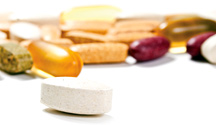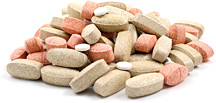Vitamins have become increasingly popular since William Fletcher concluded in 1905 that “special factors” had a great deal to do with health and disease, and the term vitamine was coined by Polish scientist Casimir Funk in 1912. Although countless research articles have been published and nearly everyone has consumed vitamin products at some point during their lives, there are still quite a few misconceptions regarding vitamins, particularly vitamins in supplemental form. To that end, let’s explore some of the common myths and truths about vitamins so you can make more informed decisions when it comes to your health.
Myth: We Get All the Vitamins We Need From Food
Two hundred years ago, it might have been possible to supply the body with all the vitamins, minerals and nutrients it requires without the need for additional supplementation. However, with the use of chemicals and modern farming practices, getting complete and pure nutrition from foods is becoming more and more difficult.
Farmland is becoming increasingly toxic due to the presence of chemicals used to enhance food growth and production. In turn, the crops grown in these soils absorb these toxic substances, rather than essential nutrients. For example, fruits and grains can absorb lead, while lettuce, corn, and wheat can absorb pesticides and cadmium, putting food supplies at risk.
 Additionally, much of our land has become progressively overfarmed. Continuous use of the same soil depletes it of beneficial microbes and minerals that are essential for healthy produce. According to Dr. William A. Albrecht, chairman of the Department of Soils at the University of Missouri, “A declining soil fertility, due to a lack of organic material, major elements, and trace minerals, is responsible for poor crops and in turn for pathological conditions in animals fed deficient foods from such soils, and … mankind is no exception.“
Additionally, much of our land has become progressively overfarmed. Continuous use of the same soil depletes it of beneficial microbes and minerals that are essential for healthy produce. According to Dr. William A. Albrecht, chairman of the Department of Soils at the University of Missouri, “A declining soil fertility, due to a lack of organic material, major elements, and trace minerals, is responsible for poor crops and in turn for pathological conditions in animals fed deficient foods from such soils, and … mankind is no exception.“
Myth: The More Vitamins You Take, the Healthier You’ll Be
We’ve been convinced, primarily through media-fostered misinformation, that mega-doses of vitamins are necessary for health. However, research has shown just the opposite is true. Since most supplements are colloidal (large molecule), synthetic, and contain inorganic elements, binders and fillers, most of the health benefits are lost or cannot be utilized properly.
Most synthetic vitamins come in several forms: powders, pills and capsules. Binders and fillers, such as dibasic calcium phosphate (DCP) and microcrystalline cellulose (MCC), used in many discounted, mass-volume supplements, cannot be broken down by the body, so they may pass right through along with the beneficial nutrients. They also can be stored in the intra- and extracellular spaces. As a result, the body does not recognize them as beneficial, but rather as foreign invaders, which can lead to auto-toxicity and various health problems.
For example, vitamin A as found in nature is referred to as retinol and carotene. Foods high in carotenoids that become vitamin A in the body do not cause toxicity. However, too much vitamin A from supplements can damage bones and lead to toxicity over the long term.
Myth: If You Take a Multivitamin, You Can Eat Whatever You Want
Many people believe vitamins can replace whole foods, so they take a daily multivitamin and don’t worry about eating nutritious foods. This is a big mistake. Vitamins cannot function without the energy generated from complex carbohydrates, healthy fats, and lean sources of protein. Therefore, it is important to consume a variety of foods that supply energy and vitamins naturally. If deficiencies exist, additional supplements in the right form and combination can compensate for these deficiencies.
Myth: All Vitamins Are Absorbed Equally, Regardless of When They’re Taken and in What Combination
The type of vitamin and its source are crucial to how absorbable the vitamin really is. Many pill- and capsule-form vitamins simply are not absorbed properly due to the processed and compressed nutrients. ThePhysicians’ Desk Reference suggests that only 10 percent to 20 percent of the nutrients in solid vitamins are actually absorbed by the body, whereas liquid vitamins are absorbed at nearly 98 percent. Additionally, nutrients are better absorbed when in the correct proportions. For example, it is essential that vitamins and minerals are taken together, as vitamins cannot fulfill their role in cellular metabolism without minerals. Trace minerals serve as catalysts to vitamins within the cell.
 Additionally, some nutrients are more effective depending on when they are taken. As a general rule, vitamins are best taken with meals, since most vitamins and minerals are derived from our food, and typically would be digested and absorbed best in the company of real food.
Additionally, some nutrients are more effective depending on when they are taken. As a general rule, vitamins are best taken with meals, since most vitamins and minerals are derived from our food, and typically would be digested and absorbed best in the company of real food.
For example, B vitamins are best consumed at mealtime, as they make some people queasy when taken on an empty stomach. On the other hand, particular calcium supplements, such as calcium carbonate, are best taken immediately after a meal, and iron supplements should be taken on an empty stomach. Fat-soluble vitamins like vitamins A, D, E, and K require fats for proper absorption, and many vitamins require some protein to be properly digested and utilized.
Myth: Any Vitamin Product Is Good, as Long as You’re Taking Something
Not all vitamin supplements are created equally. For the past several decades, the health industry has been promoting thousands of various vitamin brands. However, many vitamin supplements contain petroleum derivatives and/or hydrogenated sugars. According to the Merck Index: An Encyclopedia of Chemicals, Drugs and Biologicals (12th Edition), even though they are often labeled as “natural,” most nonfood vitamins are isolated substances and crystalline in structure. Vitamins found naturally in real food are not crystalline and are never isolated.
Myth: As Long as It’s “Organic,” It’s OK to Take
According to Webster’s dictionary, one definition of organic is “designating or of any chemical compound containing carbon.” Vitamin supplements, therefore, may contain misleading information because by its scientific definition, the term organic can mean nothing more than it is a carbon-containing substance. All petroleum derivatives (hydrocarbons) technically can be classified as organic. The Food and Drug Administration’s definition of organic is much different: For products to be classified as truly organic, they must contain ingredients that were “grown or created without the use of chemical pesticides, fertilizer, hormones, antibiotics, or artificially-derived chemical additives.”
“(A) company might make a product that really is natural, and label it as such, or it could be made of nine synthetic ingredients, with just a little plant extract thrown in.” This quote from Daniel Fabricant, vice president of scientific and regulatory affairs at the Natural Products Association in Washington, D.C., sheds light on how a product may be called “natural” or “organic” even if most of the contents are neither.
The U.S. government has no absolute definition of natural. Therefore, when a company uses terms such as natural or all-natural, that does not mean its vitamins are not synthetic. It is important to always check the label for proof that the product contains 100 percent natural ingredients.
Myth: Synthetic Vitamins Are Just as Effective as Natural Vitamins
This is a complete myth, and here are two examples. Vitamin C occurs naturally in fruits in two ascorbate forms with bioflavonoids. Non-food, so-called “natural” ascorbic acid, is made by fermenting corn sugar into sorbitol and then hydrogenating it until it turns into sorbose. Acetone (commonly referred to as nail polish remover) is then added to break the molecular bond, creating isolated, crystalline ascorbic acid. Ascorbic acid does not contain ascorbate or bioflavonoids; thus, it is too incomplete to be called vitamin C.
Another popular vitamin supplement is vitamin E. Natural vitamin E is found in foods is [d]-alpha tocopherol, whereas chemical synthesis produces dl-alpha-tocopherol, which is synthetic. Natural vitamin E has up to four times the antioxidant capacity of synthetic vitamin E. In addition, synthetic vitamin E has less ability to correct vitamin E deficiencies than vitamin E from food. The body retains natural vitamin E 2.7 times better than synthetic forms.
 To put it simply, natural vitamins cannot be invented. The fact that some drugs are similar chemically to vitamin D as found in foods does not make them true vitamins. It is important to read the labels of all supplements to see if the products are truly 100 percent food. If even one USP vitamin synthetic substitute is listed, then the entire product is probably not real food. The best source of vitamins comes from certified organic foods grown in fertile soil and organic, real-food supplements that contain the proper combination of nutrients to make vitamins effective.
To put it simply, natural vitamins cannot be invented. The fact that some drugs are similar chemically to vitamin D as found in foods does not make them true vitamins. It is important to read the labels of all supplements to see if the products are truly 100 percent food. If even one USP vitamin synthetic substitute is listed, then the entire product is probably not real food. The best source of vitamins comes from certified organic foods grown in fertile soil and organic, real-food supplements that contain the proper combination of nutrients to make vitamins effective.
Myth: If You Take Vitamins Regularly, You Don’t Need to Exercise
There is no substitute for exercise. The body requires proper nutrition and consistent physical activity to optimize function. The benefits of circuit training, a 30-minute walk, or other physical activity cannot be replaced – especially for people who are overweight or have high-blood pressure or a heart condition. Just consider this quote from F. Patrick Robinson, a biobehavioral research fellow at the University of Illinois-Chicago: “There’s a decade of research that shows that aerobics and weight lifting can reverse metabolic complications. Some studies have revealed that exercise helps decrease triglyceride levels and may help with the reduction of localized weight gain and improve sensitivity to insulin.”